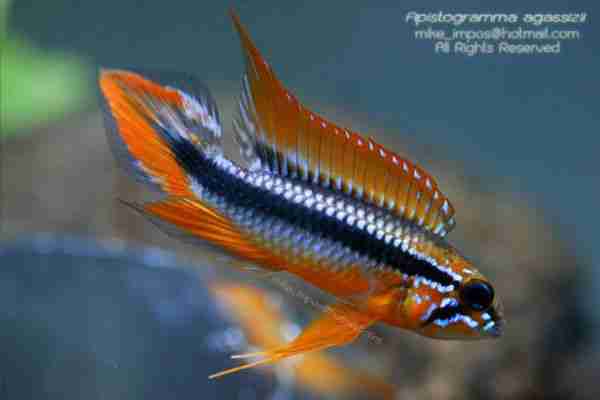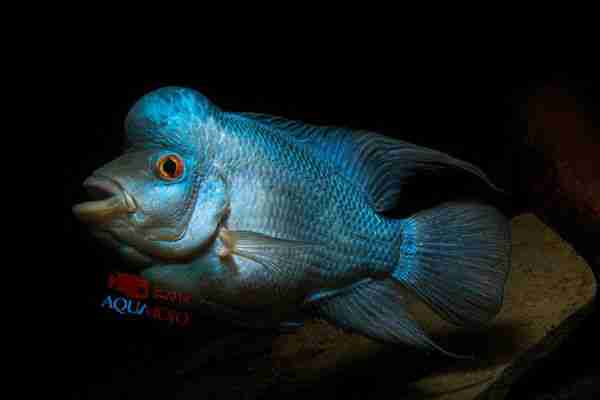
Recently there has been a marked uptick in what some consider designer fish, especially cichlids. Breeders have come to replace the frankenfish title of hybrids that were generally bland and unidentifiable. Today there are a multitude of beautifully colored strains and creations that do not, and in all likelihood would never, exist in the wild.
Part of the allure for keeping fish is that they are colorful, come from a natural environment, and exhibit natural behaviors. These fish have adapted and survived over time that allowed their environments to accommodate them, let them thrive, and to reproduce largely at their convenience. Through extensive programs breeders have developed fish that have surpassed their original parentage in color, finnage, and physique. We saw this in the early 1950’s with livebearers such as guppies and platies so it’s not new.
The American Cichlid Association used to maintain a strictly opposing view of the hybrid fish. Three years of discussions passed before the ACA came to soften its views on hybrids. Arguments for only non-hybrids were common among purists but some such as Mo Devlin who once held position in the ACA as the Chairman of the Board of Directors thought otherwise.
“I felt that the logic of WHY people didn’t approve of the fish was seriously flawed. The argument was if people were willing to accept the line bred creations like the fruit colored discus, super red fish, long finned, the various flavors of Angelfish, etc. then there was NO excuse NOT to accept the hybrid fish.” Mo Devlin says after he had an epiphany on the subject.
Up until a point in time hybrid cichlids were mostly bland and colorless fish. Evidence is clear that this Apistogramma agassizi pictured here that was bred by Narongpol Chaiyabutr is a beautiful fish. It was created by careful breeding through a selective program to produce such a striking specimen. A lot of time and effort has been put into creating and maintaining the line.
Often hobbyists and breeders create fish hybrids that are not readily identifiable and could be sold as a species they are not. This is where some contention and friction comes from amidst the throngs of aquarium hobbyists keeping cichlids. There are already several fish that are no longer living in the wild and by all means and accounts are extinct in nature. Their only populations exist in the aquariums of organizations and hobbyists throughout the world.
 With the amount of deforestation and habitat loss we are experiencing some fear that the wild populations could disappear and the captive fish could be cross bred into extinction by muddying the genetics of the rare and endangered fish that hobbyists keep in their tanks.
With the amount of deforestation and habitat loss we are experiencing some fear that the wild populations could disappear and the captive fish could be cross bred into extinction by muddying the genetics of the rare and endangered fish that hobbyists keep in their tanks.
What was once a niche hobby has become wide scale especially throughout the cichlid community. The now common flowerhorn is the bane of existence to many purists in the cichlid hobby, and the blood parrot made way for it. Shortly after the flowerhorn and its giant nuchal hump arrived the red Texas became popular and soon the electric blue Jack Dempsey made its debut. Today there are many cichlids with the electric blue gene to be found in almost every fish store. Even major chain pet stores carry ebjd, as the electric blue Jack Dempsey is often referred to as.
“For 40 years, I have worked with some of the most unusual and rare snakes and fish I could find. My specialty was identification. I loved the puzzle of discovering the secrets of unknown specimens brought to my attention.” Frank Menser exclaims.
“More and more I see the increasing numbers of designer animals and hybrids to the point when it seems whenever a picture is posted, people automatically guess hybrid – rather than species.”
Frank is not alone. There are many clubs, organizations, and hobbyists that would prefer to keep only location populations or pure strains.
To add to the discussion of purity over designer fish we also have the issue of pet quality versus natural populations. In the wild fish can look quite different than what they have been line bred to produce for the aquarium trade. Aquarium breeders try to get the most color and best fin traits to produce a product that will sell better.
Line breeding is taking the same species and using selected related specimens to improve the look or qualities of them. When it comes to the issue of line breeding, there are many examples of fish coming from a specific location and only having one importation. By this means, it could be construed as all being line bred, as they all come from the same parentage but have been selectively bred from there. The only difference being the intent. Apistogramma cacatuoides ‘double red’ is a good example of selectively line bred specimens although new examples are coming out regularly among the dwarf cichlid breeders.
Maintaining a captive population with the original natural population in mind is something many dedicated hobbyists try to strive for. There are a large number of African cichlids that typically have their location of collection names kept with them. They often show variance in color and other physical traits from location to location. The cyphotilapia frontosa is a well known example of this.
Hybrids have been created all around the world using ex cichlasoma trimaculatum, from the first flowerhorns to the brilliantly blue colored Thai Silk pictured above. Likely, no one aside from the original breeders know what went into creating these fish. They may not even know themselves. Trimaculatus are suspect of being a main contributor and as such some claim it to be so, however we don’t really know. What we do know is that many of those central and south American cichlids will interbreed somewhat readily and this helps create new hybrids. With the help of hormones and artificial means of breeding some of the not so likely may also join in.
A large cross section of the aquarium hobby keeping hybrids such as Flowerhorns, Thai Silk, and Red Texas are younger enthusiasts. Young people are an important aspect of the aquarium hobby, and the aquarium trade. Hybrids are good at introducing young people to the aquarium hobby so that they may continue along.
“Bringing people into the hobby in any way only ensures that their interests will grow and the likelihood of them moving on to or including pure species in their collection increase.” Mo Devlin expresses.
As a solid counter to the frankenfish as some call the new hybrids, serious aquarists create beautiful and elaborate biotope tanks. These tanks are very specific and detailed to tailor to the needs of location population and other pure fish. These biotopes mimic specific locations, and often house specimen quality fish often complete with complimentary fish that would also be found in the same areas as the specimen. There are countless resources for this and it has gained a large following in the last decade.
In the grand scheme of things a fish is still a fish, regardless of whether or not its parentage comes from a dozen or more different contributors. What the difference is lies amongst the hobbyists themselves who collect both original location populations, aquariums strains, or breeder created tank busters with giant nuchal humps. To protect and continue the natural populations it all comes down to maintaining a line of information to the fish in your tank, especially when getting rid of them or breeding them for sale or trade. This should be done whether you have wild caught natural populations, line bred tank raised, or hybrids.
Photo courtesy: Apistogramma aggasizi – Narongpol Chaiyabutr
Photo courtesy: Mo Devlin – Thai Silk Flowerhorn https://www.facebook.com/aquamojo
 Biotope One A Study of Flora and Fauna
Biotope One A Study of Flora and Fauna 


